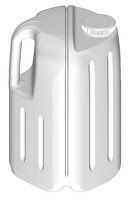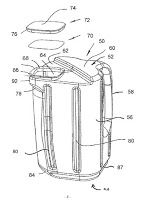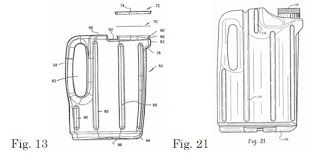The Board affirmed a Section 2(e)(5) refusal of the container configuration shown below, for "milk," finding the design to be de jure functional. Applicant's utility patent was sufficient to establish a prima facie case of functionality that applicant failed to overcome. In re Creative Edge Design Group, Ltd., Serial No. 87287662 (May 9, 2019) (corrected on May 13, 2019 to not precedential] (Opinion by Judge Karen Kuhlke).

The CAFC's Morton-Norwich opinion sets forth the following factors to be considered in determining whether a design is de jure functional: (1) the existence of a utility patent disclosing the utilitarian advantages of the design; (2) advertising materials in which the originator of the design touts the design's utilitarian advantages; (3) the availability to competitors of functionally equivalent designs; and (4) facts indicating that the design results in a comparatively simple or cheap method of manufacturing the product.
Utility Patent: The existence of a utility patent "is strong evidence that the features claimed therein are functional" and "[w]here the expired patent claimed the features in question, one who seeks to establish trade dress protection must carry the heavy burden of showing that the feature is not functional, for instance by showing that it is merely an ornamental, incidental, or arbitrary aspect of the device." TrafFix, 58 USPQ2d 1005. Moreover, "statements in a patent's specification illuminating the purpose served by a design may constitute equally strong evidence of functionality." Becton, Dickinson & Co., 102 USPQ2d at 1377.
Applicant is the owner of expired U.S. Patent No. 6068161, for "Stackable, Thin-walled Containers Having a Structural Load Distributing Feature Permitting Caseless Shipping." It contended that this patent does not "discuss the utililitarian advantages of the cuboidal shape, size, and appearance" of the design, arguing that the "central advance" of the patent is the structural load-distributing feature that transfers load from the top to the base of the container, allowing for efficient stacking of the containers. The abstract of the patent describes the "substantially planar" and parallel surfaces of the top and base of the container and side walls that include a "structural load distributing feature."

The Board found that many of the patent claims "bear directly on the applied-for trade dress, including the cuboidal shape." The patent specification references the cost effectiveness of stackability and caseless shipping. Two of the patent figures depict embodiments "very similar to the applied-for design."

The Board concluded that the specification and claims of the patent "reveal the functionality of the design."
The applied-for aspects in the application, "generally cuboidal in shape," "substantially flat and square shaped top surface," "generally flat sides" and "handle form[ing] the upper part of the corner defined by two of the side walls and extend[ing] to the flat top surface of the bottle," are all referenced in the utility patent and are not "merely an ornamental, incidental, or arbitrary aspect of the packaging."
The Board therefore found that the patent "is sufficient to establish a prima facie case that the design is functional."
Advertising: Examining Attorney Jonathan R. Falk submitted excerpts from news articles that "contain photographs of the applied-for mark" and include claims of the benefits of the design - namely, self-stacking and resulting lower transportation costs. Although this evidence was not applicant's advertising, it still tends to show consumer exposure to the "touting" of these functional aspects.
Applicant argued that it is seeking a registration for "milk," not for containers, and the advantages discussed do not make the jug's shape functional for milk. The Board was not impressed: "The stackability feature is a utilitarian advantage whether the applied-for goods are containers for milk or milk. This advantage begins when the containers are filled with milk, and continues as the milk is distributed to and then sold at the store."

Alternative Designs: Applicant asserted that there are a multiplicity of alternative designs, but the Board noted that the examples submitted did not clearly show the same stackability feature, and "may have aspects that would not be amenable to caseless stacking." In any case, once functionality is found based on other considerations, there is no need to consider alternative designs." Becton, Dickinson & Co., 102 USPQ2d at 1377. [Doesn't this make the prima facie patent evidence conclusive, if the Board will not consider applicant's evidence? - ed.].
Cost of Manufacturing: Applicant argued, without evidence, that it had to incur significant expense in changing its manufacturing process, but the Board pointed out that the cost advantage comes from reduced transportation costs, nor from the manufacturing process. Moreover, even if the container is not "comparatively simple or cheap to manufacture, this does not mean that the design is not functional."
Conclusion: The Board affirmed the refusal.
Based on the evidence, competitors would need this cuboidal shape to achieve the same advantages for distributing and selling milk. To afford registration to Applicant's design would inhibit legitimate competition by in effect extending the lifespan of its monopoly previously afforded by its now expired utility patent. Mars Inc., 105 USPQ2d at 1866.
The content of this article is intended to provide a general guide to the subject matter. Specialist advice should be sought about your specific circumstances.
